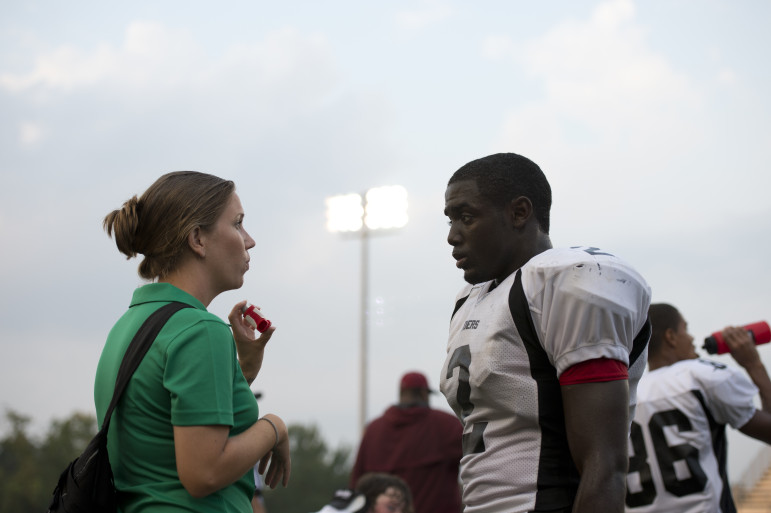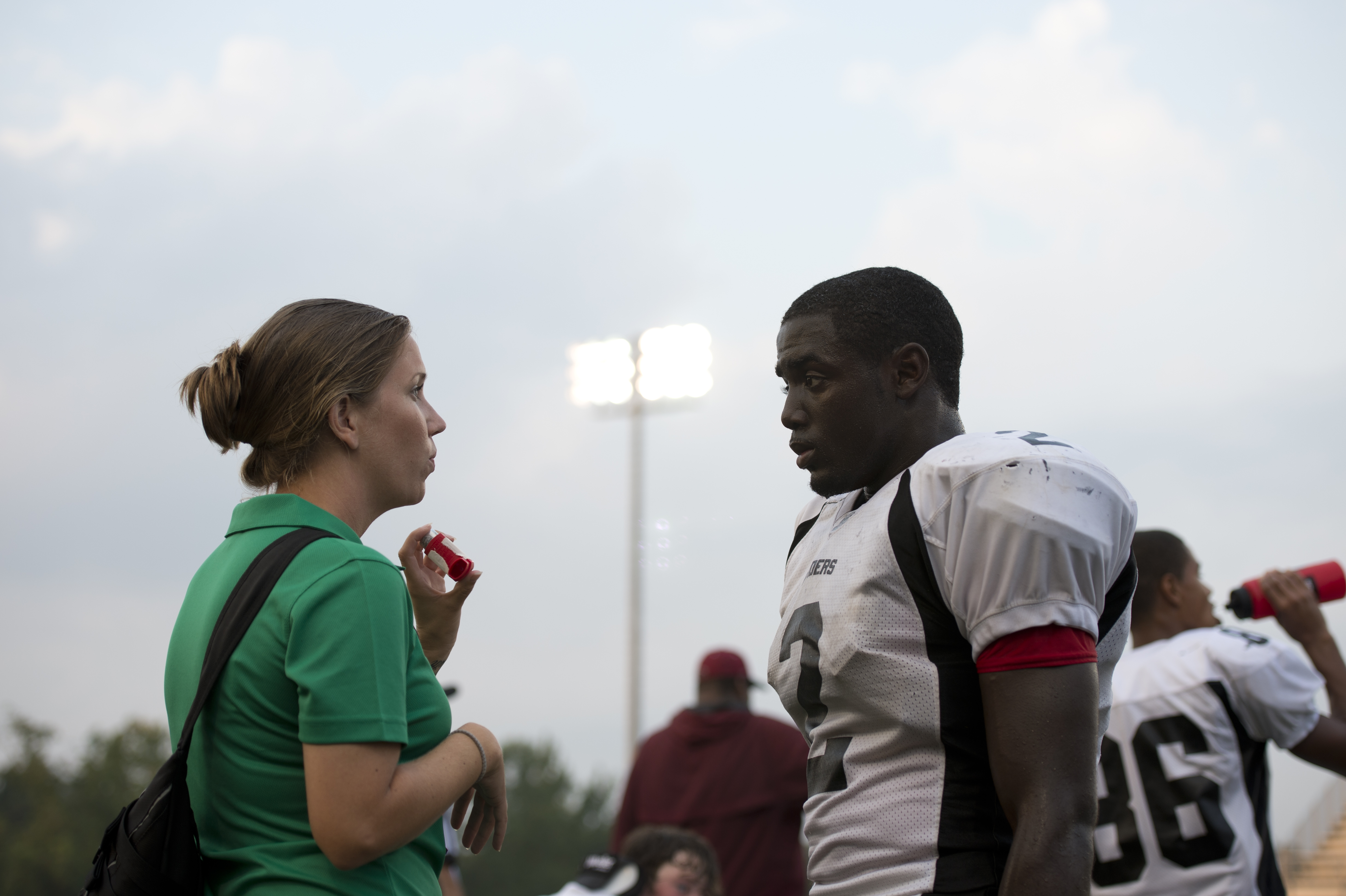
Children's Healthcare of Atlanta
Laura Lyles, head athletic trainer, with player Stephan Perry at Alpharetta High School.
ATLANTA — In 1954, the Texas A&M coach Paul “Bear” Bryant took a squad of players to Junction, Texas, and practiced all day in brutal heat. It was dangerous because Bryant did not allow sufficient drinking water. It also did nothing to make his team formidable, as far as wins and losses. The Aggies finished 1-9.
Still, for 50 years, college and high school coaches across the country have clung to the Bryant ideals and raised hosannas to the Bear for building toughness in his team with grueling workouts in the heat. A book was written and a movie was made based on the Junction Boys. The tradition of multiple practices in one day during preseason camp thrived for decades.
The so-called “two-a-days” and “three-a-days,” however, are going the way of phones with cords, at least in the college game. There is a culture change taking over football, or climate change, whatever you want to call it as college teams get back on the practice field in early August.
“Coaches here have told us they don’t even need two-a-days anymore,” said Jack Marucci, the head athletic trainer at Louisiana State University. “It wasn’t like it used to be where kids started camp and needed to get in shape. Kids are already in shape. It is antiquated to think you need two-a-days to get kids in shape.”
The competitiveness of football — teams battling rivals, high school teenagers clawing for scholarships — has created a generation of ambitious players who keep themselves in shape for a year-round game. Many high schools permit spring practice and players have to be in shape to compete for a position so they train most of the winter.
College programs have mandatory “voluntary” summer workouts where their entire 100-man squad is in the weight room at 7 a.m. When you interview players about being made to be on campus in the summer, most welcome it as a chance to stay in shape for the coming season and get better.
What the continuous workouts do is get players better prepared for the rigors of fall camp, but there is still work that needs to be done. There must be safeguards in place.

Children's Healthcare of Atlanta
Harold King, Manager of Sports Medicine Athletic Training and Community Outreach for Children’s Healthcare of Atlanta.
“Even though you work out and do seven-on-seven you still need a week or so to get acclimated to the temperature and humidity again,” said Harold King, the Manager of Sports Medicine Athletic Training and Community Outreach for Children’s Healthcare of Atlanta (CHOA). “Coaches were trying to get in as much work as they can and that’s when you run into trouble — deaths and heat stroke and heat illness.
An offense of a quarterback and receivers without linemen up against a defense of linebackers and defensive backs constitute a seven-on-seven. There is no blocking or tackling.
“Coaches were saying ‘You’re just out of shape, run harder’ and that’s when you had the catastrophic occurrences.”
The heat is dangerous for all players, but particularly for African-American players who might have the sickle cell anemia trait. Marucci said one of the first things players are blood tested for when they arrive at LSU is whether they have the sickle cell trait, which can be exacerbated by excessive heat and humidity.
“If they have the trait, they are the first ones we pull back,” he said.
Starting in 2013, the Georgia High School Athletic Association banned three-a-day practices and said a team could not practice twice in a day on consecutive days. The rule changes were in response to a University of Georgia study that found the state of Georgia had more heat-related deaths among high school football players than any other state — 8 from 1994 to 2011.
It is vital for schools to have an athletic trainer present during all practices, but especially during summer drills when the temperature is in the 90s and the humidity makes the air even more stifling.
King says 40 to 45 percent of high schools in the state of Georgia do not have athletic trainers, which is why CHOA has a program where it will put a trainer at a high school in exchange for minimal cost and allowing CHOA a marketing presence on campus.
The athletic trainers can use a sling psychrometer to measure the amount of water vapor in the air, or humidity. If it is above a certain reading they are required to instruct coaches who must take players off the field. Coaches whose teams do not have athletic trainers are trained how to use the sling psychrometer, or so-called “wet bulb” device and check it every hour.
King said there had to be a culture change among head coaches because many grew up in the era of three-a-days and two-a-days.
“You can’t tell an old school guy not practicing that day wasn’t going to hurt his team,” King said. “With anything that is football-related it is a tough thing to change the coach’s mindset.”
King and Marucci and other athletic trainers have tried to show coaches their teams are better off in the long run.
“The hot climate cities can affect short-term and long-term ability of players because the practices in the heat can suck the life out of the body and it is hard to regain that,” Marucci said. “Mentally, you start to wear down in camp and it has a carryover effect into the season.”
“With dehydration comes fatigue of the brain and fogginess, so if a kid can’t get out of the way, he gets blasted and sustains a concussion,” King said. “He can be out for an extended period of time. If he can’t get out of the way and somebody falls on his leg and he tears an ACL, he is done for the year.”
Alan Chadwick, the head football coach at Marist School in Atlanta, whose teams have won two state championships under Chadwick, said high school football teams are not better off in the long run with reduced practice time.
College football is vastly different from high school football in time devoted to practice, Chadwick said.
“The college programs get a month and a half for spring practice, we get 10 days and most of the time it is about eight days, and a lot of times we don’t have all of our players because they are playing other sports,” said Chadwick, who has been the head coach at Marist for 30 years.
“These are high school kids who haven’t had much football experience and some of them are new to the game. We need numbers of practices in order to get repetitions in order to be able to execute our system.
“I don’t want to give up more football time. We’re giving up time to every other sport.”
He said his players are never out on the field for more than two hours and 10 minutes on the days when there are two-a-days and they are carefully monitored by a certified athletic trainer. Water breaks and down time are routine for Marist players and it is not an oppressive slog in the heat, hour after hour after hour.
Marucci said the N.C.A.A., the national governing body of college athletics, could ban two-a-days completely in the next two years, but Chadwick hopes that does not happen in the high school game.































